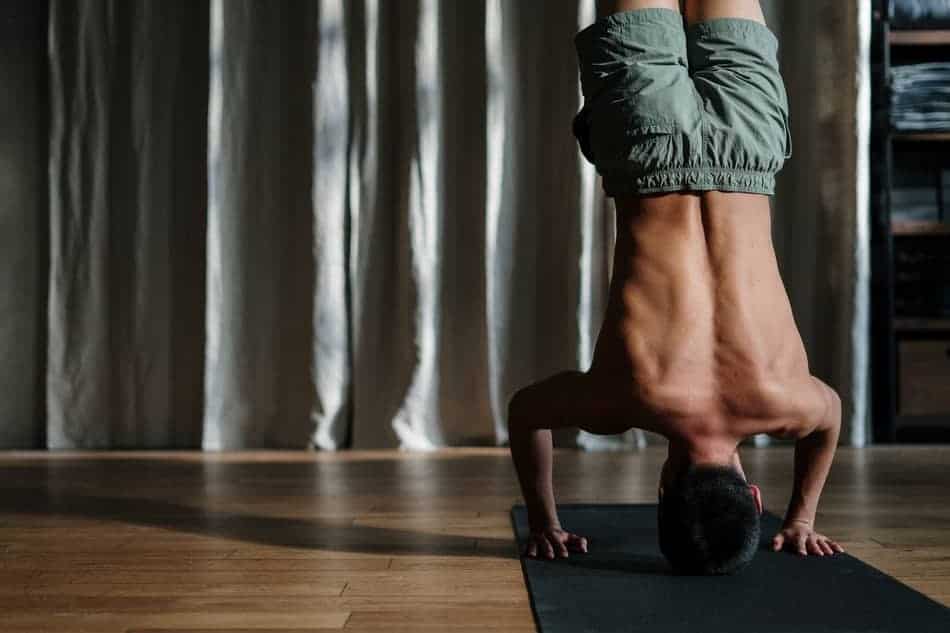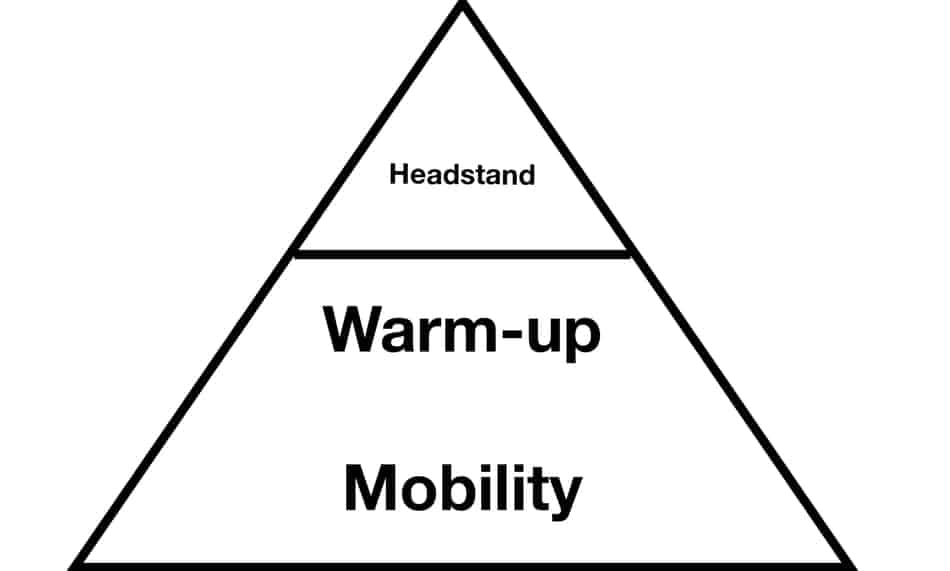You shouldn’t do a headstand right after eating. When food enters the stomach, it starts digestion, enzyme secretion, and peristaltic movements.
This makes the blood flow into your gut and can result in bad digestion, bloating, and nausea.

So it’s not worth it. But it doesn’t mean that you need to train on an empty stomach. It’s all about the right timing.
When should you do headstands?
It will really depend on the amount of food you had, and the type of meal you eat.
How long should you wait after your meal?
In general, it takes around 2-3 hours for the food to get digested. For some foods like fruits and vegetables, it can take less.
For others, like red meat, it can take substantially longer.
Let me quickly remind you about how food is affecting our body, so you can get clear on whether should you be exercising right after the meal or not.
We have two types of nervous systems that our body operates in.
The sympathetic nervous system (also known as the fight or flight response) and the parasympathetic nervous system (also known as the rest and digest).
Headstand before eating
This is when you are awake and stimulated to action, or to some emergencies. This is when you get excited, full of adrenaline, and ready to act.
It’s kind of like when someone jumps out from behind the door and makes you scared.
Or, when you’re under some cognitive or physical stress (aka exercise). That’s when your body pumps the blood into the muscles and primes them for a response.
Your heart rate spikes up, your breathing is up, and your blood pressure rises.
The sympathetic nervous system is what you want when you exercise
Headstand after eating
The parasympathetic nervous system is when you are relaxed. Think of it like your sleep mode.
This is when the adrenaline rush is already gone. Your body was maybe exposed to some challenges, maybe even dangerous, and now it’s a healing time.
Heart rate is calm, same as blood pressure.
This is when your body grows, stores energy, or rests.
It’s this feeling when your belly is full after finishing this last piece of the auntie’s pumpkin pie.
This is typical during sleep, nap, just after a meal, or just after sex.
You feel relaxed.
The parasympathetic nervous system pushes the blood away from your muscles back into the gut. This allows you to digest your food better
So the last thing you want is to mix those two systems together. This means you don’t want to eat while you are in the hurry. And you don’t want to do 20 burpees just after the sex.
How much food you can eat before the headstand?
If you have a proper meal then I would suggest waiting at least 2-3 hours. But if you’re having a light snack, small smoothie, or fruit juice, then it’s ok to wait for 30-minutes.
For example, competitive runners are known to “eat” while they run. They ingest a liquid gel that gives them plenty of sugar, so they can continue running.
However, some data shows that long-distance runners are known for their GI disturbances, predominantly of the lower tract.
This is due to eating while running.
You don’t want that.
If you just finished a substantial meal let if sit there for 2-3 hours.
What kind of food you can eat before headstand?
Fruits and vegetables take usually up to an hour to get fully digested and moved from the stomach into the small intestines.
Proteins take longer. (Especially meat.)
It can take even up to a few hours.
So if you have a big, hearty meal full of protein then I would suggest waiting 2-3 hours.
However, if you just had a banana then you will be fine after 30-minutes.
Here you can see how long it actually takes for your meal to fully transit the body.
(See the graph below.)

Plus it all depends on individual characteristics, like age, gender, diet, hormonal balance, enzymatic production, physical activity, body mass, etc.
So it’s definitely not one-size-fits-all.
What is the best time to do a headstand?
Now you know how the food is behaving in our body, so let’s get back into training.
Headstand is an advanced movement. It requires good flexibility, coordination, and balance. And ideally, for the best results, you want to be already properly warmed up.
The best time to do a headstand is after a solid warm-up session.
Doesn’t matter what time of the day you choose to train. As long as you are warmed up, awake, and not tired, you will find it much easier to do a headstand.
After spending years onboard cruise ships I’ve noticed that all of the entertainment crew, like dancers and acrobats, are spending a notably long amount of time doing the warm-up, and mobility exercises.
And there is a good reason for it.
It makes them more flexible. And when you’re more flexible, you can do any complex movements much easier.
For me, it almost feels like running in super-tight jeans versus running in light shorts. It’s just so much more comfortable.
I’ve never seen anyone going cold turkey on the show. It just never happened. And if did happen, then sooner or later you will hear about someone going home because of the injury.
Not good.
But after a good warm-up, you feel like your muscles are better prepared, they feel light and supple. In this state, it almost feels effortless to perform.
This means you would need first spend the majority of your time to get ready.
It looks almost like this.

A lot of people do it backward. They spend some time on warm-up and move on to the headstand.
Conclusion
You can do a headstand after an hour if you have a small snack. Something like a banana or other fruit. This type of fruit is easily digested and gives you energy.
There is no reason why you should not do a headstand, as part of your daily exercise or yoga practice. Some people practice yoga twice a day and they do inverted poses in both sessions.
